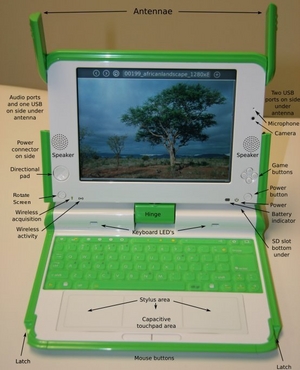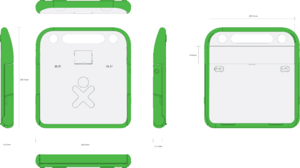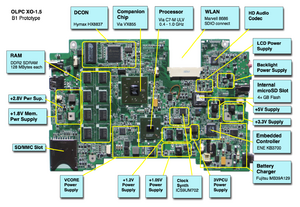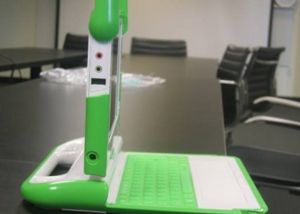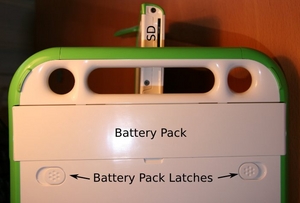Especificaciones Hardware XO-1.5: Difference between revisions
(New page: {{Translation | lang = es | source = XO-1.5 | version = 219819}} {{Ongoing Translation}} {{TOCright}} ==The XO-1.5 hardware refresh== The XO-1.5 laptop is the central focus of One Laptop...) |
No edit summary |
||
| (13 intermediate revisions by one other user not shown) | |||
| Line 1: | Line 1: | ||
{{Translation | lang = es | source = |
{{Translation | lang = es | source = Hardware_specification_1.5 | version = 219819}} |
||
{{Ongoing Translation}} |
|||
{{TOCright}} |
{{TOCright}} |
||
==La actualización del hardware XO-1.5== |
|||
==The XO-1.5 hardware refresh== |
|||
La laptop XO-1.5 es el foco central de One Laptop Per Child en el 2009. |
|||
Una actualización del [[XO-1]] está en marcha. En nuestro esfuerzo contínuo para manterner una precio bajo, OLPC está actualizando el hardware para sacar ventaja de las últimas tecnologías en componentes. Ésta actualización (Generación 1.5) es un proyecto separado de [[Gen 2.0]], y va a continuar usando el mismo diseño industrial y baterías que la Gen 1. El objetivo del diseño es proveer una actualización general al sistema dentro del mismo DI (diseño industrial) y apariencia externa. |
|||
En términos generales, la meta es mantener el precio y el bajo consumo eléctrico del Gen 1 XO-1; haciendo al mismo tiempo al procesador más activamente "haragán" (ahorrando batería). Es muy probable que alcancemos las metas. |
|||
Overall, the target is to match the Gen 1 XO-1 in power consumption while making aggressive suspend easier, and in price (while changing to components which are more likely to decrease in price). It is likely that both goals can be met. |
|||
También esperamos que las máquinas Gen 1.5 se entreguen con un nuevo OS: [[F11_for_1.5|new software release]], basado en Fedora 11, e incluyendo tanto Sugar como GNOME. |
|||
== |
== Especificaciones == |
||
[[Image:drawing75c1.jpg|thumb|right]] |
[[Image:drawing75c1.jpg|thumb|right]] |
||
[[Image:Olpc XO dim-Optimized.png|thumb| |
[[Image:Olpc XO dim-Optimized.png|thumb|Gráfico reducido de un XO - haga click para agrandar]] |
||
La especificación definitiva del XO-1.5 ''no está disponible aún'', sin embargo, en muchos sentidos es comparable al [[Media:CL1A_Hdwe_Design_Spec.pdf|XO-1 (pdf)]]. |
|||
=== |
===Dimensiones físicas=== |
||
* |
* Dimensiones aproximadas: 242mm × 228mm × 32mm (vea la imagen a la derecha para dimensiones detalladas) |
||
* Peso aproximado: |
|||
* Approximate weight: |
|||
** XO |
** Laptop XO con batería LiFePO4: 1.45KG (~3.20lbs); NO CONFIRMADO |
||
** XO |
** Laptop XO con batería NiMH: 1.58KG (~3.48lbs); NO CONFIRMADO |
||
* Configuración: Laptop convertible con pantalla pivotante y reversible; carcasa del sistema resistente a suciedad y humedad; sin ventiladores ni ranuras de ventilación. |
|||
* Configuration: Convertible laptop with pivoting, reversible display; dirt- and moisture-resistant system enclosure; no fan. |
|||
=== |
===Electrónica central=== |
||
* |
* Una foto de la [[XO 1.5 Motherboard|Placa madre del XO 1.5]] está disponible con notas. |
||
* CPU: [http://www.via.com.tw/en/products/processors/c7-m_ulv/ Via C7-M Ultra Low Voltage x86-compatible processor] |
* CPU: [http://www.via.com.tw/en/products/processors/c7-m_ulv/ Via C7-M Ultra Low Voltage x86-compatible processor] con cache L2 de 128KB ; |
||
** No hay ''datasheet'' disponible aún. ''Todos los datasheets de los chips estarán disponibles públicamente cuando la laptop esté en producción. En éste momento están aún siendo escritos y corregidos para publicación.'' |
|||
** No datasheet is publicly available. ''All the chip data sheets should be publicly available when this laptop reaches production. At this time, they are still being written and reviewed for release.'' |
|||
* CPU clock speed: 400 MHz (1.5 W) |
* CPU clock speed: 400 MHz (1.5 W) a 1GHz (5 W), variable. La reloj se ralenta automáticamente cuando es necesario para mantener la CPU dentro de los parámetros termales. Éstos cambios de velocidad suceden muy rápido, lo mismo que la caída de voltaje del procesador (0.728V en C3/C4, comparado con 0.798V en C0). |
||
* |
* El instruction-set es compatible con Intel-compatible (incluyendo MMX, SSE, SSE2 & SSE3) |
||
* |
* Chips de ''compañía'': [http://www.via.com.tw/en/products/chipsets/v-series/vx855 Via VX855] provee la interfaz de memoria, motor gráfico 3D, decodificador de vídeo HD, USB, SDIO y otras interfaces de sistema y gestión. |
||
** No hay ''datasheet'' disponible aún |
|||
** ''No datasheet is publicly available'' |
|||
** |
** El VX855 es un avance incremental sobre el 800/820. Aquí está el [http://linux.via.com.tw/support/beginDownload.action?eleid=161&fid=241 manual para el VX800/820], y aquí el del GPU Chrome9 [http://www.x.org/docs/via/OGPM_Chrome9%20HC3_R100a_Part1_Core_2D.pdf 2D graphics] and [http://www.x.org/docs/via/OGPM_Chrome9%20HC3_R100a_Part2_3D_Video.pdf 3D and video]. |
||
* Embedded controller: ENE KB3700 or ENE KB3700B; |
* Embedded controller: ENE KB3700 or ENE KB3700B; |
||
** [[Ec_specification|Embedded Controller]]: [[Media:KB3700-ds-01.pdf|ENE KB3700]] |
** [[Ec_specification|Embedded Controller]]: [[Media:KB3700-ds-01.pdf|ENE KB3700]] |
||
* DRAM |
* Memoria DRAM : 1 GiB dynamic RAM; data rate: DDR2 SDRAM; |
||
* BIOS: 1 MiB SPI-interface flash ROM; |
* BIOS: 1 MiB SPI-interface flash ROM; |
||
* Open Firmware |
* Usamos Open Firmware para cargar el sistema operativo; |
||
* |
* Almacenamiento: 4 GiB NAND flash en una tarjeta internamicroSD card (no reeplazable por el usuario, hay que abrir la unidad con un destornillador). También hay una ranura para tarjetas SD, como en el XO-1. |
||
* |
* Discos: sin discos. |
||
[[Image:XO_1.5_B1_Annotated_Motherboard.png|thumb| |
[[Image:XO_1.5_B1_Annotated_Motherboard.png|thumb|Placa madre prototipo]] |
||
{{anchor|Display}} |
{{anchor|Display}} |
||
{{anchor|Display}} |
|||
{{main|Display}} |
|||
===Pantalla=== |
|||
* [[Display |Liquid-crystal display]]: 7.5” dual-mode TFT display; |
|||
* Viewing area: 152.4 mm × 114.3 mm; |
|||
* Pantalla de cristal líquido (LCD): 7.5” (19.05 cm) Dual-mode TFT display |
|||
* Two "modes" depending on lighting conditions: |
|||
* Area visible: 152,4 mm × 114,3 mm |
|||
:(1) Grayscale (B&W) reflective mode: for outdoor use—sunlight-readable; primarily lit from the front by ambient light; high-resolution (200 DPI), 1200(H) × 900(V) grayscale pixels; power consumption 0.1–0.2Watts; |
|||
* Resolución: 1200 (H) × 900 (V) resolución (200 dpi) |
|||
:(2) Color, backlight mode: for indoor use; primarily lit from behind by the LED backlight; built in sub-pixel sampling of the displayed color information results in a perceived resolution of approximately [http://pixelqi.com/blog1/2008/05/27/higher-resolution-than-we-thought-the-xo-laptop-screen/ 984(H) × 738(V)]; power consumption 0.2–1.0Watts; |
|||
* Dos modos de uso, para distintas condiciones de iluminación: |
|||
* The [[DCON|display-controller chip (DCON)]] with memory that enables the display to remain live with the processor suspended. The DCON also formats data for the display. |
|||
** Modo reflectivo: Alta resolución, modo monocromático reflectivo |
|||
* This [[Display | Liquid-crystal display]] is the basis of our extremely low power architecture. The XO is usable while the CPU and much of the motherboard is regularly turned off (and on) so quickly that it's imperceptible to the user. Huge power savings can perhaps be harvested in this way (e.g. by turning stuff on the motherboard off when it's not being used (if even for a few seconds), while keeping the display on). |
|||
** Pantalla Color: 800 (H) x 600 (V), muestreo quincunx, modo color transmisivo |
|||
* Consumo: 0.1 Watt sin luz de fondo; 0.2-1.0 Watt con iluminación de fondo |
|||
[[Image:EToys - new display.jpg|thumb|right|eToys ([[Squeak/lang-es|Squeak]]) corriendo en la pantalla OLPC]] |
|||
* El [[DCON|display-controller chip (DCON)]] brinda una memoria que permite que la pantalla permanece encendida mientras la CPU "duerme" -- diseñado para uso como ebook de bajo consumo. |
|||
Ésta pantalla, combinada con el DCON es la base de nuestra arquitectura de extremadamente bajo consumo. El XO es usable mientras la CPU y gran parte de la placa madre están "dormidas", y éstas se despiertan tan rápido que es imperceptible para el usuario. |
|||
Gen 1.5 continua con la pantalla diseñada para Gen 1, mientras al mismo tiempo OLPC sigue trabajando con [http://www.pixelqi.com PixelQi] para mejorar el brillo y la eficiencia.. |
|||
===Periféricos integrados=== |
|||
* Teclado: 80+ teclas, recorrido de 1.2mm; sellados por una membrana de goma, ensamblaje tecla-switch |
|||
: ''Note: web browser images are currently scaled up so that an image of very roughly [800 × 600] fills up the browser window.'' |
|||
** [[OLPC_Keyboard_layouts|Diagramación de los Teclados]] |
|||
** Imágenes de los diagramas: [[:Image:Keyboard english.png|English]], [[:Image:Keyboard arabic.png|Arabic]], [[:Image:Keyboard thai.png|Thai]], [[:Image:NG-MP-alt.png|West African (Nigeria)]], [[:Image:BR-MP-v1.png|Portuguese]], [[:Image:ES-MP-v1.png|Spanish]], [[:Image:Ethiopic-B3.png|Amharic]], [[:Image:Rwanda-B3.png|French]], [[:Image:Urdu-MP.png|Urdu]], [[:Image:RU-MP-v1.png|Cyrillic]], [[:Image:TR-MP-v1.png|Turkish (not final)]], [[:Image:NP-MP-v1.png|Nepali]], [[:Image:MO-MP-v1.png|Mongolian]], [[:Image:KA-MP-v1.png|Kazakh]], [[:Image:MR-MP-v2.png|Devanagari]], [[:Image:UZ-MP.png|Uzbek]], [[:Image:PS-MP.png|Pashto]], [[:Image:AF-MP.png|Dari]], [[:Image:FF-MP.png|Pulaar (Fula)]], [[:Image:IT-MP.png|Italian]] |
|||
* Teclas de Cursor: ensamble de cinco teclas para el cursor; cuatro direccionales más 'enter' |
|||
* Gamepad: Dos grupos de 4 teclas de dirección; |
|||
* Touchpad: capacitivo; |
|||
* Audio: subsistema de audio compatible con HD Audio ; Amplificador y parlantes estéreo internos; micrófono interno monofónico; conectores para auriculares y micrófonos externos; |
|||
** Codec Conexant CX20582 y tal vez [http://www.analog.com/ Analog Devices SSM2302] para amplificación de audio NO CONFIRMADO |
|||
* Cámara de video: [http://www.ovt.com/products/part_detail.asp?id=53 Omnivision OV7670],resolución 640x480, 30CPS (cuadros por segundo - FPS / frames per second). Tanto la cámara como el piloto soportan la desactivación del AGC y balance automático de color, permitiendo su utilización como un sensor fotométrico para aplicaciones educativas. |
|||
* [[Wireless| Red Wifi]]: Intefaz integrada 802.11b/g (2.4GHz); antenas duales y ajustables permiten amplia recepción; |
|||
** Chip WiFi Marvell [[Libertas]] [[88W8686]], con interfaz SDIO montado en un módulo removible; se mantiene activo mientras la laptop duerme, despertándola si le llegan paquetes a través de la red. Es probable que modelos tempranos no tengan soporte directo para 802.11s pero estamos trabajando con Marvell sobre soluciones para 802.11s. |
|||
* Indicadores de estado: conexión eléctrica, batería, y Wifi, visible con la pantalla abierta o cerrada; micrófono en uso y cámara en uso visibles cuando la pantalla está abierta. |
|||
Gen 1.5 will continue with the existing display, although OLPC is working with [http://www.pixelqi.com PixelQi] to try to improve the brightness and efficiency of the screen. |
|||
=== |
===Conectores externos=== |
||
* Alimentación: entrada de corriente continua (CC) de 2 contactos de 6mm (1.65mm pin central), 11 a 18 V utilizables. La entrada tolera de -32 a 40 V; consumo limitado a 25W - para más detalle sobre las dimensiones del conector, vea [[Battery and power#Mechanical|Battery and power]]. |
|||
* Keyboard: 80+ keys, 1.0mm stroke; sealed rubber-membrane key-switch assembly; |
|||
* Linea de salida: Conector estándar (jack) de 3.5mm, estéreo de 3 contactos |
|||
** [[OLPC_Keyboard_layouts|Keyboard Layouts]] |
|||
* Micrófono: Conector estándar (jack) de 3.5mm, mono de 2 contactos; modo de entrada configurable: |
|||
** Layout pictures: [[:Image:Keyboard english.png|English]], [[:Image:Keyboard arabic.png|Arabic]], [[:Image:Keyboard thai.png|Thai]], [[:Image:NG-MP-alt.png|West African (Nigeria)]], [[:Image:BR-MP-v1.png|Portuguese]], [[:Image:ES-MP-v1.png|Spanish]], [[:Image:Ethiopic-B3.png|Amharic]], [[:Image:Rwanda-B3.png|French]], [[:Image:Urdu-MP.png|Urdu]], [[:Image:RU-MP-v1.png|Cyrillic]], [[:Image:TR-MP-v1.png|Turkish (not final)]], [[:Image:NP-MP-v1.png|Nepali]], [[:Image:MO-MP-v1.png|Mongolian]], [[:Image:KA-MP-v1.png|Kazakh]], [[:Image:MR-MP-v2.png|Devanagari]], [[:Image:UZ-MP.png|Uzbek]], [[:Image:PS-MP.png|Pashto]], [[:Image:AF-MP.png|Dari]], [[:Image:FF-MP.png|Pulaar (Fula)]], [[:Image:IT-MP.png|Italian]] |
|||
** Sensor, CC con 2.5 V de polarización (impedancia de 3 kilo ohm) para pulsadores, teclas, sensores resistivos, etc. |
|||
* Gamepad: Two sets of four-direction cursor-control keys; |
|||
** Sensor, CC sin polarización para mediciones de voltaje (0 - 3 V) |
|||
* Touchpad: Capacitance touchpad |
|||
** Micrófono externo, CA con polarización |
|||
* Audio: HD Audio compatible audio subsystem; Internal stereo speakers and amplifier; internal monophonic microphone; jacks for stereo external headphones and microphones; |
|||
* Expansión: 3 conectores USB-2.0 Tipo-A; proveen hasta 1A de corriente(total) |
|||
** Conexant CX20582 codec and maybe [http://www.analog.com/ Analog Devices SSM2302] for audio amplification? UNREVIEWED |
|||
* Slot para MMC/SD-Card |
|||
[[Image:AP1 15.jpg|thumb|100px|Keyboard detail]] |
|||
* Camera: integrated color video camera; 640 x 480 resolution at 30 FPS; independent (and undefeatable by software) display of microphone and camera recording status; the camera and device driver support disabling AGC and automatic color balancing, to enable its use as a photometric sensor for educational applications; |
|||
** [http://www.ovt.com/products/part_detail.php?id=73 Omnivision OV7670] |
|||
* [[Wireless| Wireless Networking]]: Integrated 802.11b/g (2.4GHz) interface; dual adjustable, rotating antennas support diversity reception; |
|||
** Marvell [[Libertas]] wireless chip, [[88W8686]], with SDIO interface, on removable module; remains powered while the laptop suspends, waking the laptop if a packet addressed to it arrives. It is likely that early production models will not directly support 802.11s (i.e. forwarding mesh packets while the interface is asleep), but we are working with Marvell on several different 802.11s solutions. |
|||
[[Image:Rotate-1.jpg|thumb|Conectores]] |
|||
* Status indicators: Power, battery, and WiFi (2), visible with lid open or closed; Microphone In-Use, and Camera In-Use, visible when lid is open. |
|||
=== |
===Batería=== |
||
* DC power: 6mm (1.65mm center pin) connector; 11 to 18 V input usable, –32 to +40V input tolerated; power draw limited to 25 W; - see power connector dimensions at [[Battery and power#Mechanical|Battery and power]]. |
|||
* Headphone output: standard 3.5mm 3-pin switched stereo audio jack; |
|||
* Microphone input: standard 3.5mm 3-pin switched stereo microphone jack; selectable 2V DC bias; selectable sensor-input mode (DC or AC coupled); |
|||
* USB: Three Type-A USB 2.0 connectors; Up to 1A power supplied (total); |
|||
* Flash Expansion: [[SD]] Card slot. |
|||
* Tipo de batería: 2 o 4 celdas LiFePO4; o 5 celdas NiMH, configuración en serie de aprox. 6V (sujeto a cambios); |
|||
[[Image:Rotate-1.jpg|thumb|Connectors]] |
|||
* Capacidad: 16.5 Watt-hours (NIMH), 22 Watt-hours (LiFeP); |
|||
* Empaque sellado "duro/rígido"; removible por el usuario |
|||
* La electrónica incorporada en el empaque provee: |
|||
===Battery=== |
|||
** Identificación |
|||
* Pack type: 2 or 4 cells LiFePO4; or 5 cells NiMH, approx. 6V series configuration (subject to change); |
|||
** Información sobre carga y capacidad ([[Media:DS2756.pdf|Maxim DS2756 data sheet]]); |
|||
* Capacity: 16.5 Watt-hours (NIMH), 22 Watt-hours (LiFeP); |
|||
** Sensores térmico y de sobrecarga así como switch de corte para la protección de la batería |
|||
* Fully-enclosed “hard” case; user removable; |
|||
* Ciclo de vida: Mínimo 2,000 ciclos de carga/descarga (hasta 50% de la capacidad de una nueva). |
|||
* Electronics integrated with the pack provide: |
|||
** Identification; |
|||
** Battery charge and capacity monitoring chip ([[Media:DS2756.pdf|Maxim DS2756 data sheet]]); |
|||
** Thermal and over-current sensors along with cutoff switch to protect battery; |
|||
* Minimum 2,000 charge/discharge cycles (to 50% capacity of new). |
|||
* [[Power Management]] will be critical |
|||
[[Image:Bottomdrawing.jpg|thumb|Batería]] |
|||
See [[Laptop Batteries]] or more information. |
|||
===BIOS/cargador=== |
|||
[[Image:Bottomdrawing.jpg|thumb|Battery]] |
|||
* [[Open Firmware]] es usado como el firmware, incluyendo la inicialización del hardware y "despertar" veloz (''fast resume''). |
|||
* Batería Panasonic ML1220 |
|||
===BIOS/loader=== |
|||
* [[Open Firmware]] (including hardware initialization and fast resume). |
|||
* Panasonic ML1220 battery |
|||
===Especificaciones ambientales=== |
|||
===Environmental specifications=== |
|||
* Temperatura: planeando obtener certificación UL a 45C / 50C ; A CONFIRMAR |
|||
* Temperature: UL certification planned to 45C in Q32007, pending 50C certification in mid-2008; UNREVIEWED |
|||
* Humedad: planeado obtener certificación UL IP42 (o tal vez mayor) cuando está cerrada, la unidad debería cerrar lo suficientemente bien como para que los chicos caminando a la escuela no se preocupen por polvo y lluvia; A CONFIRMAR |
|||
* Humidity: UL certification planned to IP42 (perhaps higher) when closed, the unit should seal well enough that children walking to and from school need not fear rainstorms and dust; UNREVIEWED |
|||
* |
* Altura máxima: –15m a 3048m (14.7 a 10.1 PSIA) (operando), –15m a 12192m (14.7 to 4.4 PSIA) (no-operativo); A CONFIRMAR |
||
* |
* Impacto: 125g, 2ms, medio seno (operando) 200g, 2ms, medio-seno (no-operativo); A CONFIRMAR |
||
* |
* Vibración aleatoria: 0,75g cero-a-pico, 10Hz a 500Hz, ritmo de barrido de 0.25 oct/min (operando); 1,5g cero-a-pico, 10Hz a 500Hz, ritmo de barrido de 0.5 oct/min (no-operativo) |
||
* |
* Carcasa plástica de 2mm de espesor (1,3mm es lo típico). |
||
=== |
===Requerimientos regulatorios=== |
||
* Los requerimientos típicos de los EEUU y la UE sobre [http://en.wikipedia.org/wiki/Radio_frequency_interference EMI]/[http://en.wikipedia.org/wiki/Electromagnetic_Compatibility EMC] (Interferencia y Compatibilidad Electro Magnética) serán respetados; |
|||
* The usual US and EU EMI/EMC (electromagnetic-interference and electromagnetic-compatibility) requirements will be met; |
|||
* |
* La laptop está diseñada para respetar IEC 60950-1, EN 60950-1, y CSA/UL 60950-1. También cumplirá con UL 1310 and UL 498. Para asegurar la seguridad de los chicos que la usan, pasa ASTM F 963; |
||
* |
* La fuente eléctrica cumple con IEC, EN, y CSA/UL 60950-1; |
||
* |
* La batería removible cumple con IEC, EN, y CSA/UL 60950-1 y UL 2054; |
||
* Cumple con RoHS (Directiva de Restricción de Substancias Peligrosas - UE) |
|||
* RoHS (Restriction of Hazardous Substances Directive – EU) compliant. |
|||
==Tiempos de desarrollo de la laptop== |
|||
==Laptop Development Schedule== |
|||
Versiones tempranas del hardware (placas madres) deberían estar disponibles para desarrollo de drivers hacia fin de mayo 2009; vea [[XO1.5 Bringup]] y [[XO 1.5 A1]]. Un número más grande de prototipos (varios cientos) para desarrollo de software y testeo deberían estar disponibles hacia el fin de agosto 2009. El [[contributors program|programa de colaboradores de OLPC]] será el mechanismo para pedir máquinas Gen 1.5 para probar su software en cuanto a compatibilidad y para nuevo desarrollo. Esperamos usar éste programa para ayudar a que haya soportte para Gen 1.5 en los programas y soluciones creadas para Gen 1.0. |
|||
== |
==Adaptador Serial== |
||
[[Image:serialadapter.jpg|100px|right]] |
[[Image:serialadapter.jpg|100px|right]] |
||
Para conservar partes y espacio, si bien la placa madre provee un puerto serie para debugging, no provee traductores de voltaje para implementar el protocol RS-232 completamente. Así que es necesario un [[Serial_adapters|adaptador 3.3V TTL a RS-232 (o USB)]]. |
|||
<br clear="all"> |
<br clear="all"> |
||
== |
== Más información == |
||
* [http://blog.laptop.org/2009/04/17/announcing-the-xo-15-updated-hardware-for-the-xo-laptop/ |
* [http://blog.laptop.org/2009/04/17/announcing-the-xo-15-updated-hardware-for-the-xo-laptop/ Anuncio original del Fen 1.5] el 17 de abril del 2009. |
||
* |
* [[Hardware specification|Especificaciones de Hardware XO-1]] |
||
* [[Hardware Testing]]: |
* [[Hardware Testing]]: Certificaciones de Seguridad y Solidez |
||
* [[Hardware]] |
* [[Hardware]] y [[:Category:Hardware]] |
||
[[category:Hardware]] |
[[category:Hardware]] |
||
Latest revision as of 18:47, 5 April 2013
| Traducción de Hardware_specification_1.5 | original |
| english | español +/- | cambios |
La actualización del hardware XO-1.5
La laptop XO-1.5 es el foco central de One Laptop Per Child en el 2009.
Una actualización del XO-1 está en marcha. En nuestro esfuerzo contínuo para manterner una precio bajo, OLPC está actualizando el hardware para sacar ventaja de las últimas tecnologías en componentes. Ésta actualización (Generación 1.5) es un proyecto separado de Gen 2.0, y va a continuar usando el mismo diseño industrial y baterías que la Gen 1. El objetivo del diseño es proveer una actualización general al sistema dentro del mismo DI (diseño industrial) y apariencia externa.
En términos generales, la meta es mantener el precio y el bajo consumo eléctrico del Gen 1 XO-1; haciendo al mismo tiempo al procesador más activamente "haragán" (ahorrando batería). Es muy probable que alcancemos las metas.
También esperamos que las máquinas Gen 1.5 se entreguen con un nuevo OS: new software release, basado en Fedora 11, e incluyendo tanto Sugar como GNOME.
Especificaciones
La especificación definitiva del XO-1.5 no está disponible aún, sin embargo, en muchos sentidos es comparable al XO-1 (pdf).
Dimensiones físicas
- Dimensiones aproximadas: 242mm × 228mm × 32mm (vea la imagen a la derecha para dimensiones detalladas)
- Peso aproximado:
- Laptop XO con batería LiFePO4: 1.45KG (~3.20lbs); NO CONFIRMADO
- Laptop XO con batería NiMH: 1.58KG (~3.48lbs); NO CONFIRMADO
- Configuración: Laptop convertible con pantalla pivotante y reversible; carcasa del sistema resistente a suciedad y humedad; sin ventiladores ni ranuras de ventilación.
Electrónica central
- Una foto de la Placa madre del XO 1.5 está disponible con notas.
- CPU: Via C7-M Ultra Low Voltage x86-compatible processor con cache L2 de 128KB ;
- No hay datasheet disponible aún. Todos los datasheets de los chips estarán disponibles públicamente cuando la laptop esté en producción. En éste momento están aún siendo escritos y corregidos para publicación.
- CPU clock speed: 400 MHz (1.5 W) a 1GHz (5 W), variable. La reloj se ralenta automáticamente cuando es necesario para mantener la CPU dentro de los parámetros termales. Éstos cambios de velocidad suceden muy rápido, lo mismo que la caída de voltaje del procesador (0.728V en C3/C4, comparado con 0.798V en C0).
- El instruction-set es compatible con Intel-compatible (incluyendo MMX, SSE, SSE2 & SSE3)
- Chips de compañía: Via VX855 provee la interfaz de memoria, motor gráfico 3D, decodificador de vídeo HD, USB, SDIO y otras interfaces de sistema y gestión.
- No hay datasheet disponible aún
- El VX855 es un avance incremental sobre el 800/820. Aquí está el manual para el VX800/820, y aquí el del GPU Chrome9 2D graphics and 3D and video.
- Embedded controller: ENE KB3700 or ENE KB3700B;
- Memoria DRAM : 1 GiB dynamic RAM; data rate: DDR2 SDRAM;
- BIOS: 1 MiB SPI-interface flash ROM;
- Usamos Open Firmware para cargar el sistema operativo;
- Almacenamiento: 4 GiB NAND flash en una tarjeta internamicroSD card (no reeplazable por el usuario, hay que abrir la unidad con un destornillador). También hay una ranura para tarjetas SD, como en el XO-1.
- Discos: sin discos.
Pantalla
- Pantalla de cristal líquido (LCD): 7.5” (19.05 cm) Dual-mode TFT display
- Area visible: 152,4 mm × 114,3 mm
- Resolución: 1200 (H) × 900 (V) resolución (200 dpi)
- Dos modos de uso, para distintas condiciones de iluminación:
- Modo reflectivo: Alta resolución, modo monocromático reflectivo
- Pantalla Color: 800 (H) x 600 (V), muestreo quincunx, modo color transmisivo
- Consumo: 0.1 Watt sin luz de fondo; 0.2-1.0 Watt con iluminación de fondo
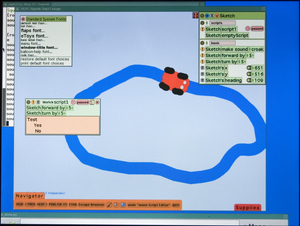
- El display-controller chip (DCON) brinda una memoria que permite que la pantalla permanece encendida mientras la CPU "duerme" -- diseñado para uso como ebook de bajo consumo.
Ésta pantalla, combinada con el DCON es la base de nuestra arquitectura de extremadamente bajo consumo. El XO es usable mientras la CPU y gran parte de la placa madre están "dormidas", y éstas se despiertan tan rápido que es imperceptible para el usuario.
Gen 1.5 continua con la pantalla diseñada para Gen 1, mientras al mismo tiempo OLPC sigue trabajando con PixelQi para mejorar el brillo y la eficiencia..
Periféricos integrados
- Teclado: 80+ teclas, recorrido de 1.2mm; sellados por una membrana de goma, ensamblaje tecla-switch
- Diagramación de los Teclados
- Imágenes de los diagramas: English, Arabic, Thai, West African (Nigeria), Portuguese, Spanish, Amharic, French, Urdu, Cyrillic, Turkish (not final), Nepali, Mongolian, Kazakh, Devanagari, Uzbek, Pashto, Dari, Pulaar (Fula), Italian
- Teclas de Cursor: ensamble de cinco teclas para el cursor; cuatro direccionales más 'enter'
- Gamepad: Dos grupos de 4 teclas de dirección;
- Touchpad: capacitivo;
- Audio: subsistema de audio compatible con HD Audio ; Amplificador y parlantes estéreo internos; micrófono interno monofónico; conectores para auriculares y micrófonos externos;
- Codec Conexant CX20582 y tal vez Analog Devices SSM2302 para amplificación de audio NO CONFIRMADO
- Cámara de video: Omnivision OV7670,resolución 640x480, 30CPS (cuadros por segundo - FPS / frames per second). Tanto la cámara como el piloto soportan la desactivación del AGC y balance automático de color, permitiendo su utilización como un sensor fotométrico para aplicaciones educativas.
- Red Wifi: Intefaz integrada 802.11b/g (2.4GHz); antenas duales y ajustables permiten amplia recepción;
- Chip WiFi Marvell Libertas 88W8686, con interfaz SDIO montado en un módulo removible; se mantiene activo mientras la laptop duerme, despertándola si le llegan paquetes a través de la red. Es probable que modelos tempranos no tengan soporte directo para 802.11s pero estamos trabajando con Marvell sobre soluciones para 802.11s.
- Indicadores de estado: conexión eléctrica, batería, y Wifi, visible con la pantalla abierta o cerrada; micrófono en uso y cámara en uso visibles cuando la pantalla está abierta.
Conectores externos
- Alimentación: entrada de corriente continua (CC) de 2 contactos de 6mm (1.65mm pin central), 11 a 18 V utilizables. La entrada tolera de -32 a 40 V; consumo limitado a 25W - para más detalle sobre las dimensiones del conector, vea Battery and power.
- Linea de salida: Conector estándar (jack) de 3.5mm, estéreo de 3 contactos
- Micrófono: Conector estándar (jack) de 3.5mm, mono de 2 contactos; modo de entrada configurable:
- Sensor, CC con 2.5 V de polarización (impedancia de 3 kilo ohm) para pulsadores, teclas, sensores resistivos, etc.
- Sensor, CC sin polarización para mediciones de voltaje (0 - 3 V)
- Micrófono externo, CA con polarización
- Expansión: 3 conectores USB-2.0 Tipo-A; proveen hasta 1A de corriente(total)
- Slot para MMC/SD-Card
Batería
- Tipo de batería: 2 o 4 celdas LiFePO4; o 5 celdas NiMH, configuración en serie de aprox. 6V (sujeto a cambios);
- Capacidad: 16.5 Watt-hours (NIMH), 22 Watt-hours (LiFeP);
- Empaque sellado "duro/rígido"; removible por el usuario
- La electrónica incorporada en el empaque provee:
- Identificación
- Información sobre carga y capacidad (Maxim DS2756 data sheet);
- Sensores térmico y de sobrecarga así como switch de corte para la protección de la batería
- Ciclo de vida: Mínimo 2,000 ciclos de carga/descarga (hasta 50% de la capacidad de una nueva).
BIOS/cargador
- Open Firmware es usado como el firmware, incluyendo la inicialización del hardware y "despertar" veloz (fast resume).
- Batería Panasonic ML1220
Especificaciones ambientales
- Temperatura: planeando obtener certificación UL a 45C / 50C ; A CONFIRMAR
- Humedad: planeado obtener certificación UL IP42 (o tal vez mayor) cuando está cerrada, la unidad debería cerrar lo suficientemente bien como para que los chicos caminando a la escuela no se preocupen por polvo y lluvia; A CONFIRMAR
- Altura máxima: –15m a 3048m (14.7 a 10.1 PSIA) (operando), –15m a 12192m (14.7 to 4.4 PSIA) (no-operativo); A CONFIRMAR
- Impacto: 125g, 2ms, medio seno (operando) 200g, 2ms, medio-seno (no-operativo); A CONFIRMAR
- Vibración aleatoria: 0,75g cero-a-pico, 10Hz a 500Hz, ritmo de barrido de 0.25 oct/min (operando); 1,5g cero-a-pico, 10Hz a 500Hz, ritmo de barrido de 0.5 oct/min (no-operativo)
- Carcasa plástica de 2mm de espesor (1,3mm es lo típico).
Requerimientos regulatorios
- Los requerimientos típicos de los EEUU y la UE sobre EMI/EMC (Interferencia y Compatibilidad Electro Magnética) serán respetados;
- La laptop está diseñada para respetar IEC 60950-1, EN 60950-1, y CSA/UL 60950-1. También cumplirá con UL 1310 and UL 498. Para asegurar la seguridad de los chicos que la usan, pasa ASTM F 963;
- La fuente eléctrica cumple con IEC, EN, y CSA/UL 60950-1;
- La batería removible cumple con IEC, EN, y CSA/UL 60950-1 y UL 2054;
- Cumple con RoHS (Directiva de Restricción de Substancias Peligrosas - UE)
Tiempos de desarrollo de la laptop
Versiones tempranas del hardware (placas madres) deberían estar disponibles para desarrollo de drivers hacia fin de mayo 2009; vea XO1.5 Bringup y XO 1.5 A1. Un número más grande de prototipos (varios cientos) para desarrollo de software y testeo deberían estar disponibles hacia el fin de agosto 2009. El programa de colaboradores de OLPC será el mechanismo para pedir máquinas Gen 1.5 para probar su software en cuanto a compatibilidad y para nuevo desarrollo. Esperamos usar éste programa para ayudar a que haya soportte para Gen 1.5 en los programas y soluciones creadas para Gen 1.0.
Adaptador Serial
Para conservar partes y espacio, si bien la placa madre provee un puerto serie para debugging, no provee traductores de voltaje para implementar el protocol RS-232 completamente. Así que es necesario un adaptador 3.3V TTL a RS-232 (o USB).
Más información
- Anuncio original del Fen 1.5 el 17 de abril del 2009.
- Especificaciones de Hardware XO-1
- Hardware Testing: Certificaciones de Seguridad y Solidez
- Hardware y Category:Hardware
